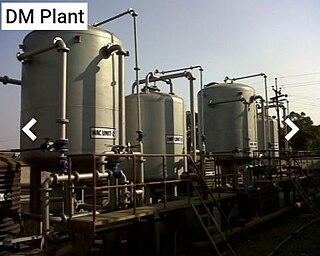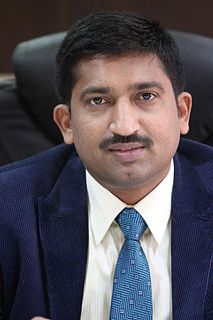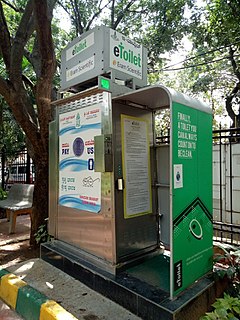
A pit latrine, also known as pit toilet or long drop, is a type of toilet that collects human feces in a hole in the ground. Urine and feces enter the pit through a drop hole in the floor, which might be connected to a toilet seat or squatting pan for user comfort. Pit latrines can be built to function without water or they can have a water seal. When properly built and maintained, pit latrines can decrease the spread of disease by reducing the amount of human feces in the environment from open defecation. This decreases the transfer of pathogens between feces and food by flies. These pathogens are major causes of infectious diarrhea and intestinal worm infections. Infectious diarrhea resulted in about 700,000 deaths in children under five years old in 2011 and 250 million lost school days. Pit latrines are a low cost method of separating feces from people.

Manual scavenging is a term used mainly in India for the manual removal of untreated human excreta from bucket toilets or pit latrines by hand with buckets and shovels. It has been officially prohibited by law in 1993 due to it being regarded as a caste-based, dehumanizing practice. It involves moving the excreta, using brooms and tin plates, into baskets, which the workers carry to disposal locations sometimes several kilometers away. The workers, called scavengers, rarely have any personal protective equipment.

Bindeshwar Pathak is an Indian sociologist. He is the founder of Sulabh International, an India-based social service organisation which works to promote human rights, environmental sanitation, non-conventional sources of energy, waste management and social reforms through education. He is the Brand Ambassador for Swachh Rail Mission of Indian Railways. His work is considered pioneering in social reform, especially in the field of sanitation and hygiene. He received various national and international awards for his work with this organisation. He was presented with the Lal Bahadur Shastri National Award for Excellence in Public Administration, Academics and Management for the year 2017. He was conferred with Padma Bhushan, India's third-highest civilian award in 1991.

Rapid improvements are being made in augmenting drinking water supply and sanitation in India, due to concerted efforts by the various levels of government and communities at improving coverage. The level of investment in water and sanitation, albeit low by international standards, has increased in size during the 2000s. For example, in 1980 rural sanitation coverage was estimated at 1% and reached 95% in 2018. Also, the share of Indians with access to improved sources of water has increased significantly from 72% in 1990 to 88% in 2008. At the same time, local government institutions in charge of operating and maintaining the infrastructure are seen as weak and lack the financial resources to carry out their functions. In addition, only two Indian cities have continuous water supply and according to an estimate from 2018 about 8% of Indians still lack access to improved sanitation facilities. A study by Water Aid estimated as many as 10 million Indians, or 5 percent of Indians living in urban areas, live without adequate sanitation. India comes in first place globally for having the greatest number of urban-dwelling inhabitants living without sanitation. India tops the urban sanitation crisis, has the largest amount of urban dwellers without sanitation, and the most open defecators(urban) with over 5 million people.
The Ministry of Drinking Water and Sanitation was a ministry of the Government of India formed in 2011. From May 2019, the ministry has been merged with the Ministry of Jal Shakti.
The Government of India has initiated several missions in order to achieve individual goals that together ensure the wellbeing of its citizens.

Parikipandla Narahari is an Indian civil servant employed by the Indian Administrative Services and a writer. According to Tehelka, Narahari, in his capacity as District Collector of Gwalior, is one of India's few civil servants to use social media platforms such as Twitter and Facebook to interact with citizenry to solve their problems. The issues citizens of Gwalior raise on Narahari's wall are automatically directed to concerned departments. The Better India recognized Narahari as 10 most inspiring IAS officers of the year 2017.
Open defecation is the human practice of defecating outside rather than into a toilet. People may choose fields, bushes, forests, ditches, streets, canals or other open space for defecation. They do so because either they do not have a toilet readily accessible or due to traditional cultural practices. The practice is common where sanitation infrastructure and services are not available. Even if toilets are available, behavior change efforts may still be needed to promote the use of toilets. The term "open defecation free" (ODF) is used to describe communities that have shifted to using a toilet instead of open defecation. This can happen for example after community-led total sanitation programs have been implemented.
Deviprasad Dwivedi is an Indian writer and teacher, known for his scholarship in Sanskrit literature. The Government of India honoured Sharma in 2011, with the third-highest civilian award of Padma Bhushan.
This is a list of Indian states and territories ranked before the availability of toilet facilities per household. Figures are from the 2011 census of India. In a massive cleanliness drive after the election of Narendra Modi in 2014, over 90 million toilets have been built over the course of 4 years, ferociously taking India towards an open defecation free country.
Narasaraopet Municipality is the local self government in Narasaraopet of the Indian state of Andhra Pradesh. It is classified as a first grade municipality.
This is a list of Indian states and territories ranked by their households with open defecation free in both urban and rural areas. Figures are from ministry of drinking water and sanitation. Below table shows ODF( Open Defecation Free), households with Toilets as percentage of total population.
Kunwar Bai Yadav was a supposedly 106-year-old woman who lived in a village in Dhamtari district in the central Indian state of Chhattisgarh. Inspired by the Swachh Bharat Abhiyan, she sold seven of her goats to raise the money to build a toilet at her house. In 2016, the district was declared the first in the state to be free of open defecation, and she was declared a mascot of the campaign and visited by Prime Minister Narendra Modi.
Swachh Survekshan is an annual survey of cleanliness, hygiene and sanitation in cities and towns across India. It was launched as part of the Swachh Bharat Abhiyan, which aimed to make India clean and free of open defecation by 2 October 2019. The first survey was undertaken in 2016 and covered 73 cities ; by 2019 the survey had grown to cover 4237 cities and was said to be the largest cleanliness survey in the world. The surveys are carried out by Quality Council of India.

Rishikesh Pandey better known by his stage name RishiKing is an Indian Music Composer, Rapper, Film Maker and Screenwriter. Rishikesh is the founder of the Motion Picture Production Company Hribom Productions and its Subsidiaries. His films on Public service initiatives and non-profit causes apart from his commercial ad films have gained him recognition and much praise from the government. He along with P Narahari IAS launched the MusicalProgram Swachhta Ke Sur in 2020 under Swachh Bharat Mission to make people aware, which included Bollywood singer Shaan, Shankar Mahadevan, Javed Ali, Payal Dev and Dev Negi.

An electronic toilet or eToilet is a type of public toilet that is used in India. The increase in use of eToilets is in support of Swachh Bharat Abhiyan which intends to reduce the practice of open defecation.
"Ho Halla" is an Indore Swachhta Anthem song for the 2017 edition of Swachh Survekshan, sung by Shaan, composed by Rishikesh Pandey and conceived by Parikipandla Narahari, an IAS Officer serving as the district collector. The purpose of the song was to encourage the city of Indore to achieve the highest levels of cleanliness. It became very popular in Indore with residents using the track as their caller tunes.

Goalkeepers is an initiative of the Bill and Melinda Gates Foundation. Its aim is to bring together leaders from around the world to accelerate progress toward achieving the Sustainable Development Goals (SDG). The organization also provides reports and data flow charts over SDGs progress.
















